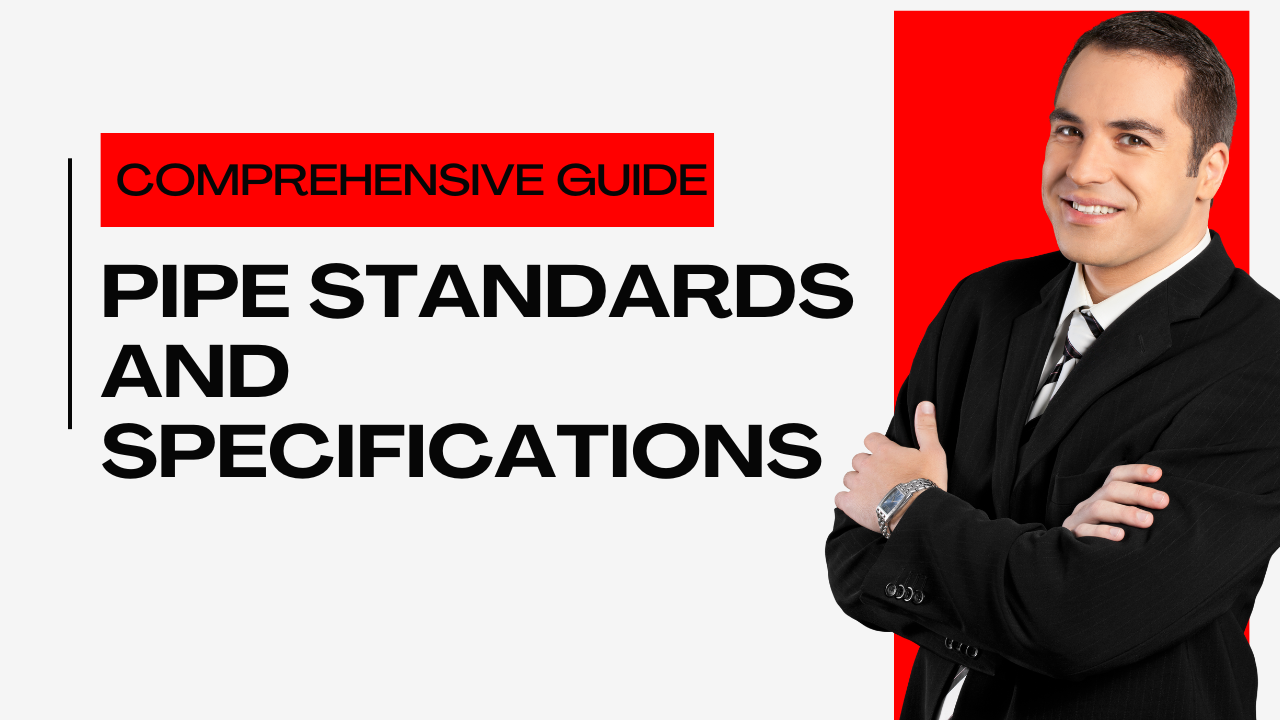Introduction
In the intricate web of industries that make up our modern world, the unassuming pipe plays a vital role. From channeling water through urban landscapes to transporting volatile substances in oil and gas fields, pipes are the unsung heroes that keep our systems running smoothly. But how do we ensure these pipes are safe, reliable, and efficient? This is where pipe Standards and Specifications come into play. In this comprehensive guide, we will delve into the historical evolution, key elements, major standards, manufacturing processes, challenges, and future trends of pipe Standards and Specifications, highlighting their paramount importance in various industries.
Table of Contents
Don’t miss the Detailed course on 7 Modules for Piping Codes & Standards
Enrollment Link
Historical Evolution of Pipe Standards and Specifications
Early Development of Pipe Manufacturing
The history of pipes dates back centuries, with early civilizations crafting pipes from materials like clay, wood, and stone. These rudimentary pipes served basic functions such as irrigation and sewage systems. However, it wasn’t until the Industrial Revolution that pipe manufacturing saw significant advancements. The advent of metalworking techniques allowed for the production of stronger and more durable pipes.
Emergence of Industrial Standards and Specifications
With the industrialization of societies came the need for standardized products. The variability in pipe dimensions, materials, and performance posed challenges to industries. This led to the development of industrial Standards and Specifications to ensure consistency and reliability. These standards defined specifications for pipe dimensions, material composition, and manufacturing processes.
Role of Government Regulations
As industries expanded, governments recognized the importance of regulating pipe quality and safety. Regulatory bodies set Standards and Specifications to safeguard public health and prevent accidents. This was particularly evident in sectors like public water supply, where substandard pipes could contaminate drinking water.
International Standardization Organizations (ISO)
The need for global consistency prompted the establishment of international standardization organizations. The International Organization for Standardization (ISO) emerged as a frontrunner in harmonizing Standards and Specifications across different countries. ISO’s efforts have played a pivotal role in promoting international trade and ensuring compatibility of pipe components.
Similar Articles related to Pipe
| Topic | Weblink | Topic | Weblink |
|---|---|---|---|
| Pipe Insulation Materials | Link | ASME B36.10 | Link |
| Piping Codes & Standards | Link | Non-Metallic Pipes | Link |
| Pressure-Temperature Ratings | Link | Pipe Standards & Specifications | Link |
| Pipes for Different Fluids | Link | Pipe Coatings & Linings | Link |
| Pipe Materials Selection Guidelines | Link | Corrosion & Pipe Protection | Link |
| High-Temperature Pipes | Link | Pipe Dimensions & Sizes | Link |
| Pipe Manufacturing Processes | Link | Types of Pipes in Piping Systems | Link |
| Pipe Thickness Calculations | Link | Pipe Inspection & Testing | Link |
Types of Pipes and Their Applications
Classification based on Material
Pipes come in a diverse range of materials, each suited to specific applications. Metallic pipes, including carbon steel, stainless steel, and alloy steel, are favored for their strength and durability. Non-metallic pipes like PVC, HDPE, and fiberglass offer corrosion resistance and flexibility, making them suitable for various purposes.
Classification based on Function
Pipes serve different functions within industries. Transportation pipes move fluids or gases from one location to another, often over long distances. Distribution pipes, on the other hand, deliver resources like water or gas to end-users. Process pipes are used within manufacturing facilities for activities like chemical processing or refining.
Common Applications in Various Industries
The oil and gas industry relies on pipelines to transport crude oil and natural gas across vast distances. Water supply systems utilize pipes to deliver clean water to homes and businesses. Chemical plants require pipes to convey raw materials and manage intricate processing tasks. These examples underscore the diverse applications of pipes in modern society.
Don’t miss the Detailed course on 7 Modules for Piping Codes & Standards
Enrollment Link
Role of Pipe Standards and Specifications in Industry
Ensuring Safety and Reliability
Safety is paramount in industries dealing with hazardous materials. Pipe Standards and Specifications establish guidelines for materials, construction, and performance to mitigate risks and ensure the well-being of workers and the general public. By adhering to Standards and Specifications, companies reduce the likelihood of accidents and environmental incidents.
Interchangeability and Compatibility of Components
In complex systems, various components must work together seamlessly. Pipe Standards and Specifications ensure that pipes and related components, such as fittings and valves, are compatible and interchangeable. This simplifies maintenance, repairs, and expansions of industrial infrastructure.
Simplifying Procurement Processes
Procuring pipes can be a daunting task, especially in global supply chains. Standardized specifications streamline the procurement process by providing clear guidelines for materials, dimensions, and performance. This facilitates efficient sourcing and minimizes the risk of purchasing subpar products.
Facilitating Global Trade and Interoperability
As industries expand beyond national borders, the need for global standardization becomes evident. Pipe Standards and Specifications that align with international norms facilitate trade, reduce trade barriers, and promote interoperability. This is especially crucial in sectors like energy, where pipelines cross continents.
Key Elements of Pipe Standards and Specifications
Dimensions and Sizes
Pipe dimensions are standardized to ensure compatibility and fit within existing systems. Standards and Specifications specify parameters like outer diameter, wall thickness, and length, which dictate the pipe’s physical characteristics.
Material Composition and Properties
The choice of material profoundly influences a pipe’s performance. Standards and Specifications outline acceptable materials and their properties, such as strength, corrosion resistance, and temperature tolerance. This ensures that the selected material can withstand the intended operating conditions.
Pressure and Temperature Ratings
Pipes often transport fluids or gases under varying pressure and temperature conditions. Standards and Specifications define the maximum allowable pressure and temperature ranges for pipes, preventing failures and ensuring safe operation.
Testing and Inspection Requirements
To validate pipe quality, Standards and Specifications mandate rigorous testing and inspection procedures. These tests assess aspects like material integrity, weld quality, and dimensional accuracy. Compliance with these requirements guarantees reliable and durable pipes.
Markings and Labeling
Clear identification is essential for traceability and maintenance. Pipe Standards and Specifications specify markings that convey crucial information, including material grade, manufacturer’s name, and production date. This facilitates proper installation, maintenance, and replacement.
Don’t miss the Detailed course on 7 Modules for Piping Codes & Standards
Enrollment Link
Major Pipe Standards and Specifications
American Standards (ASTM, ANSI, ASME)
The American Society for Testing and Materials (ASTM) creates Standards and Specifications for various materials, including pipes. The American National Standards Institute (ANSI) and the American Society of Mechanical Engineers (ASME) develop Standards and Specifications related to pipe design, fabrication, and safety.
European Standards (EN, DIN)
Europe employs the European Norm (EN) system, which covers a wide range of products, including pipes. The Deutsche Institut für Normung (DIN) in Germany also plays a significant role in setting pipe Standards and Specifications, particularly in engineering and construction.
Japanese Standards (JIS)
Japan Industrial Standards (JIS) define Standards and Specifications for industrial products, including pipes. These standards are highly regarded for their precision and quality specifications, particularly in industries like automotive manufacturing.
International Standards (ISO)
ISO Standards and Specifications provide a global framework for pipe specifications, contributing to seamless international trade. ISO standards cover various aspects of pipes, including materials, dimensions, and testing methods.
Industry-Specific Standards (API, AWWA)
Certain industries have specialized Standards and Specifications. For instance, the American Petroleum Institute (API) establishes standards for oil and gas industry pipes. The American Water Works Association (AWWA) sets standards for water-related infrastructure.
Pipe Manufacturing Processes and Standard Compliance
Seamless vs. Welded Pipes
Pipes can be manufactured through seamless or welded processes. Seamless pipes are created from a solid cylindrical piece, while welded pipes involve joining two edges. Standards and Specifications outline the manufacturing methods and quality controls for both processes.
Casting, Forging, and Extrusion Techniques
Different manufacturing techniques yield distinct pipe properties. Casting involves pouring molten metal into molds, forging shapes metal through controlled pressure, and extrusion forces metal through a die to create desired shapes. Standards and Specifications guide the selection of manufacturing methods based on the intended application.
Heat Treatment and Material Testing
Material properties are crucial for pipe durability. Heat treatment processes like annealing or quenching are often specified in Standards and Specifications to enhance material strength and resilience. Material testing ensures compliance with required properties and verifies the suitability of the material for specific conditions.
Adherence to Tolerances and Surface Finish
Pipe Standards and Specifications define tolerances for dimensions and surface finish. Tolerances ensure pipes meet precise specifications, while surface finish requirements dictate the smoothness or roughness of the pipe’s interior and exterior surfaces.
Don’t miss the Detailed course on 7 Modules for Piping Codes & Standards
Enrollment Link
Impact of Pipe Materials on Standards and Specifications
Steel Pipes (Carbon Steel, Stainless Steel, Alloy Steel)
Steel pipes are versatile and widely used in various industries due to their strength and durability. Carbon steel pipes are economical and suitable for many applications. Stainless steel pipes offer corrosion resistance, making them ideal for environments with aggressive substances. Alloy steel pipes, with their enhanced properties, cater to specialized needs.
Non-ferrous Metal Pipes (Copper, Aluminum, Titanium)
Non-ferrous metal pipes excel in scenarios where corrosion resistance is paramount. Copper pipes are commonly used in plumbing for their antimicrobial properties. Aluminum pipes are lightweight and corrosion-resistant, suitable for applications like aerospace. Titanium pipes boast exceptional strength-to-weight ratios and resistance to extreme temperatures.
Plastic Pipes (PVC, HDPE, PEX)
Plastic pipes have gained popularity for their corrosion resistance, ease of installation, and cost-effectiveness. PVC pipes are widely used in water distribution. HDPE pipes excel in demanding environments due to their flexibility and durability. PEX pipes are known for their resilience and are commonly used in plumbing and radiant heating systems.
Composite Pipes (Fiberglass, Reinforced Plastic)
Composite pipes combine the advantages of different materials. Fiberglass pipes offer high strength and corrosion resistance, making them suitable for industrial applications. Reinforced plastic pipes provide versatility and durability, with potential for customized properties.
Challenges in Developing and Updating Standards and Specifications
Technological Advancements and Innovation
Rapid technological advancements pose challenges to existing Standards and Specifications. New manufacturing techniques, materials, and applications may necessitate updates to keep pace with industry developments.
Balancing Safety and Economic Considerations
Striking a balance between safety and economic viability can be challenging. Rigorous Standards and Specifications may drive up costs, while lax standards could compromise safety. Finding the right equilibrium is crucial.
International Harmonization and Cross-Standard Compatibility
Globalization requires harmonization between national and international Standards and Specifications. Ensuring cross-standard compatibility is essential for seamless trade and collaboration across borders.
Future Trends in Pipe Standards and Specifications
Integration of IoT and Smart Technologies
The Internet of Things (IoT) is revolutionizing industries, and pipes are no exception. Smart pipes embedded with sensors can monitor conditions, detect leaks, and optimize maintenance, enhancing overall efficiency.
Sustainable and Environmentally Friendly Pipe Materials
Sustainability is a growing concern. Future Standards and Specifications may emphasize the use of eco-friendly materials and processes to reduce the environmental footprint of pipe manufacturing.
Rapid Prototyping and 3D Printing in Pipe Manufacturing
Additive manufacturing, including 3D printing, is gaining traction. This technology allows for rapid prototyping and customization of pipe designs, potentially leading to more flexible and innovative Standards and Specifications.
Continued Globalization of Industries and Standards and Specifications
As industries expand globally, the need for harmonized international Standards and Specifications will intensify. Future trends will likely focus on aligning standards across regions and industries for seamless interoperability.
Don’t miss the Detailed course on 7 Modules for Piping Codes & Standards
Enrollment Link
Case Studies: Real-world Applications of Pipe Standards and Specifications
Oil and Gas Pipeline Projects
Oil and gas pipelines are engineering marvels that span continents. Adherence to rigorous API Standards and Specifications ensures the safe transport of valuable resources over vast distances.
Water Infrastructure Development
Water scarcity highlights the importance of efficient water distribution. Standards and Specifications set by organizations like AWWA ensure reliable and safe water supply systems.
Chemical Process Plant Piping
Chemical processes require pipes that can withstand aggressive chemicals and extreme temperatures. Standards and Specifications play a crucial role in preventing chemical leaks and ensuring worker safety.
Aerospace and Automotive Industry Examples
Aerospace and automotive industries demand lightweight yet durable pipes. Precise Standards and Specifications ensure components meet stringent performance criteria in demanding environments.
Ensuring Compliance and Quality Assurance
Role of Testing Laboratories
Testing laboratories play a pivotal role in ensuring compliance with Standards and Specifications. These facilities conduct rigorous tests to verify that pipes meet specified requirements.
Certification and Third-Party Verification
Certification bodies and third-party verifiers provide independent assessments of pipe quality and adherence to Standards and Specifications. Their endorsements instill confidence in buyers and users.
Consequences of Non-compliance
Non-compliance with Standards and Specifications can have dire consequences. It can lead to accidents, environmental damage, legal liabilities, and reputational harm for companies.
Don’t miss the Detailed course on 7 Modules for Piping Codes & Standards
Enrollment Link
Conclusion
In the intricate dance of industries, pipes are the hidden choreographers that make everything flow. Pipe Standards and Specifications form the sheet music that guides their performance. From historical evolution to future trends, this comprehensive guide has unveiled the profound impact of these standards on industries worldwide. As technology advances and industries evolve, the symphony of pipe Standards and Specifications will continue to harmonize efficiency, safety, and reliability, ensuring a seamless journey into the future.
References
[1] International Organization for Standardization (ISO). (2021). ISO in brief. Link
[2] American Society for Testing and Materials (ASTM). (2021). About ASTM International. Link
[3] European Committee for Standardization (CEN). (2021). What we do. Link
[4] American Petroleum Institute (API). (2021). API standards and partnerships. Link
[5] American Water Works Association (AWWA). (2021). About AWWA. Link
[6] International Copper Association. (2021). Copper plumbing tube and fittings. Link
[7] The Aluminum Association. (2021). About aluminum. Link
[8] European Plastics Converters (EuPC). (2021). Plastic pipes. Link
[9] National Academies Press. (2004). Fiber-reinforced polymer (FRP) composites for infrastructure applications. Link
FAQs
FAQ 1: What Are Pipe Standards and Specifications?
Answer: Pipe standards and specifications are established guidelines and criteria that define various aspects of pipes used in different industries. These standards cover dimensions, materials, manufacturing processes, performance requirements, and testing procedures to ensure safety, reliability, and interoperability of pipes and related components.
FAQ 2: Why Are Pipe Standards Important?
Answer: Pipe standards are crucial for several reasons. They ensure the safety of workers and the public by setting guidelines for materials and construction that can withstand specific conditions and pressures. Standards also promote interoperability and compatibility between different components within a system, simplifying maintenance, repair, and replacement. Moreover, they facilitate global trade and help industries stay up-to-date with technological advancements.
FAQ 3: How Are Pipe Standards Developed and Updated?
Answer: Pipe standards are typically developed by international, national, or industry-specific organizations. These organizations consist of experts from various fields who collaborate to establish guidelines based on research, industry experience, and technological advancements. Standards are regularly updated to incorporate new materials, processes, and technologies, ensuring they remain relevant and effective in the ever-evolving industrial landscape.
FAQ 4: What Are Some Major International Pipe Standards?
Answer: Several major international organizations contribute to the development of pipe standards. These include:
- ISO (International Organization for Standardization): ISO standards cover a wide range of aspects related to pipes, including materials, dimensions, and testing methods.
- ASTM (American Society for Testing and Materials): ASTM standards are widely used for various materials, including pipes, and focus on testing and material specifications.
- ANSI (American National Standards Institute): ANSI develops standards that promote compatibility and interchangeability of pipes and components.
- DIN (Deutsche Institut für Normung): DIN plays a significant role in developing pipe standards, particularly in Germany and Europe, covering various aspects of engineering and construction.
FAQ 5: How Do Pipe Standards Impact Different Industries?
Answer: Pipe standards have a profound impact on a variety of industries. For example, in the oil and gas sector, adhering to standards ensures the safe transportation of valuable resources over long distances. In water distribution, standards guarantee the reliability of water supply systems. Industries like chemical processing rely on standards to prevent leaks and ensure worker safety. Additionally, the aerospace and automotive industries benefit from precise standards that meet stringent performance criteria in demanding environments. Overall, pipe standards contribute to the efficiency, safety, and reliability of industrial operations across diverse sectors.
Recommended courses (Published on EPCLand)
- Basics of Piping Engineering
- Piping Layout Engineering
- Piping Material Engineering
- Piping Stress Analysis
- Complete Course on Piping Engineering
- Material Requisitions
- Piping Material Specifications
- Valve Material Specifications
Don’t miss the published articles on following:
Related Video
Attempt Quiz
Question 1:
What is the purpose of pipe standards and specifications?
Explanation: Pipe standards and specifications are established to ensure the quality, compatibility, and safety of pipes used in various applications, ranging from industrial processes to construction.
Question 2:
Which organization is responsible for developing many of the widely recognized pipe standards?
Explanation: The American Society of Mechanical Engineers (ASME) and other organizations are responsible for developing and publishing widely recognized pipe standards that cover various aspects of pipe manufacturing, materials, and applications.
Question 3:
What does the term “NPS” stand for in pipe standards?
Explanation: “NPS” stands for Nominal Pipe Size, a standard designation used to indicate the approximate inner diameter of a pipe. It is a critical parameter in pipe specifications.
Question 4:
Which parameter is used to classify pipes based on their pressure-bearing capacity?
Explanation: Pipes are classified based on their pressure-bearing capacity using the parameter known as Pressure Class. This classification helps ensure pipes are suitable for specific applications and conditions.
Question 5:
Which type of pipe finish is often specified in pipe standards?
Explanation: Mill Finish is often specified in pipe standards. It refers to the untreated surface of the pipe as it comes from the mill, without any additional finishes or treatments.



